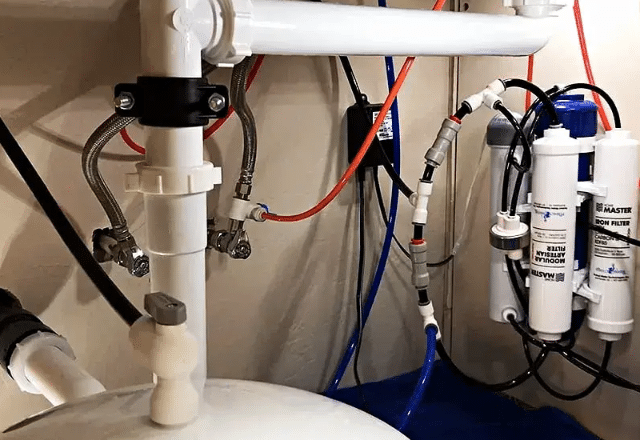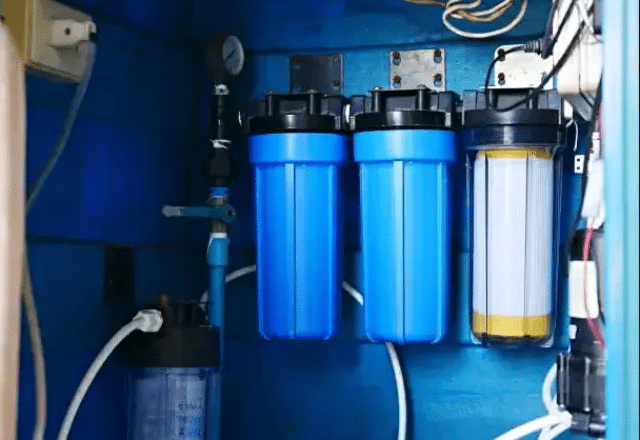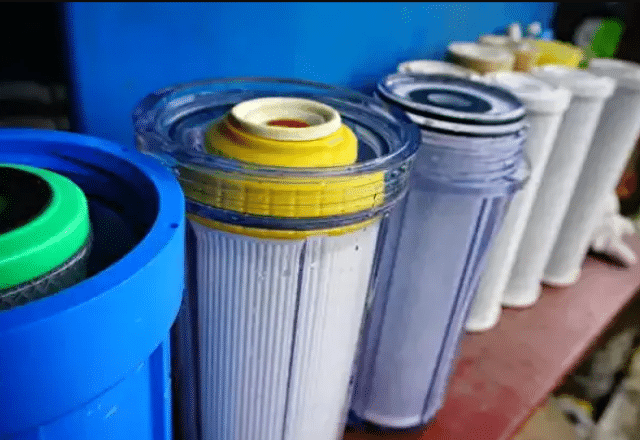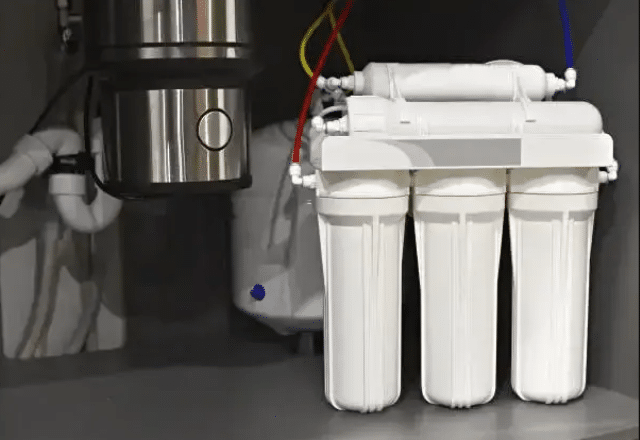
A Reverse Osmosis Water Filter System stands as an industry standard for households seeking superior water quality. This innovative system offers a reliable solution for transforming ordinary tap water into a pristine source of drinking and cooking water. Using a semipermeable membrane, it eliminates impurities and contaminants, providing an efficient and convenient way to ensure a constant supply of clean and safe potable water for everyday use.
The system’s compact design, along with its compatibility with various sink installations and convenient countertop models, makes it an accessible option for households seeking to enhance their water quality. Additionally, by eliminating membrane fouling and employing effective filter cartridges, these systems prove to be a reliable choice for homes looking to benefit from alkaline water while reducing acidic content and preserving beneficial minerals.
Reverse Osmosis (RO) is a water purification process that utilizes a semipermeable membrane to remove impurities and contaminants from water. The system works by applying pressure to the water, forcing it through the membrane, effectively separating harmful contaminants from purified water, ensuring higher water quality and eliminating various chemical and physical impurities.

A reverse osmosis (RO) water system comprises various components designed to filter and purify water, ensuring clean and safe drinking water. The primary components include:
Water Supply and Source: The system typically connects to the main water supply, drawing water from a source such as a municipal supply or well.
Sediment Filter: The process begins with a sediment filter that removes larger particles like dirt, rust, and sand from the water.
Carbon Filters: Next, the water passes through carbon filters, such as carbon block filters, which target organic compounds, chlorine, and chemical contaminants, improving taste and odor.
Reverse Osmosis Membrane: The heart of the system is the reverse osmosis membrane, a semipermeable membrane that filters out dissolved solids, contaminants, and impurities from the water.
Holding Tank: The purified water collected from the membrane is stored in a holding tank, ready for use whenever needed.
Replacement Cartridges: Over time, cartridges such as carbon block filters or sediment filters may need replacement to maintain optimal filtration performance.
Shut-off Valve and Rubber Washers: These components control the water flow and prevent leaks, ensuring efficient operation.

Filtration Stages: The water undergoes multiple stages of filtration, starting with the sediment filter to remove larger particles and then passing through carbon filters to remove chemicals and organic compounds.
Reverse Osmosis Process: The water is then pressurized and forced through the reverse osmosis membrane, which acts as a barrier, allowing only pure water molecules to pass through while trapping contaminants and dissolved solids.
Removal of Contaminants: Chemical contaminants, dissolved minerals, and harmful substances are effectively filtered out, leaving clean, purified water on one side of the membrane while flushing contaminants away.
Storage and Usage: Purified water accumulates in the holding tank, available for consumption, cooking, or any other household uses.
Disposal of Waste Water: The concentrated contaminants and impurities removed from the water are directed to a drain pipe or drain saddle, ensuring they are safely disposed of.
The result is a reliable supply of high-quality, purified drinking water, free from harmful contaminants and suitable for various household purposes, providing gallons of clean water for cooking, drinking, and everyday use.

Purified Water: The RO system ensures high-quality, purified water, free from harmful contaminants, providing potable and safe drinking water for household use.
Improved Water Quality: It removes sediment, chemicals, dissolved solids, and other impurities, ensuring cleaner and better-tasting water than standard tap water or bottled water.
Reduced Plastic Waste: With the availability of clean drinking water, reliance on bottled water diminishes, contributing to a reduction in plastic waste.
Retained Beneficial Minerals: While removing harmful contaminants, RO systems often retain essential minerals, providing clean water while preserving beneficial minerals.

Checking Water Conditions: Evaluate water conditions to determine the need for a reverse osmosis water filtration system, assessing factors like water quality, contaminants present, and water usage patterns.
Sink Location and Space: Identify a suitable location under the sink for the RO system and consider available space for storage tanks and tubing connections, ensuring a convenient and accessible set up.
Cold-Water Line and Drain Connection: Prepare for reverse osmosis setup near the cold-water line and an adjacent drain connection, ensuring proper setup and efficient operation.
Gathering Necessary Components: Collect all components required for installation, including the RO system, replacement filters, plastic tubing, faucet, and necessary tools.

Faucet Installation: Mount the reverse osmosis faucet on the sink, creating a faucet hole and securing the faucet base, ensuring a steady stream of purified water.
Tubing Connection: Establish proper tubing connections from the RO system to the faucet and drain, ensuring a secure and leak-free assembly.
Membrane Housing Setup: Install the reverse osmosis membrane housing, allowing purified water to pass through while trapping contaminants.
Storage Tanks and Filtration Stages: Place the storage tanks and sediment, carbon, and reverse osmosis filters, ensuring the proper sequence and functionality of filtration stages.

Feed Water and Pressure Testing: Test the feed water and system pressure to ensure adequate water flow and appropriate system functionality.
Water Quality Examination: Assess the quality of the filtered water by testing for contaminants and comparing it with pre-installation water conditions, ensuring successful filtration.
Faucet Performance Check: Verify the performance of the RO faucet, ensuring a consistent and reliable flow of clean, purified water.
A point-of-use RO system typically gets installed under your kitchen sink and provides filtered water through a dedicated faucet. It’s ideal for drinking and cooking water, costs less (usually $400-$1,000), and requires minimal maintenance. This system only filters water at one location, but that’s often enough since you mainly need the purest water for consumption.
A whole-home RO system, on the other hand, treats all water entering your house. It’s installed where the main water line enters your home, usually in the basement or garage. This means every tap, shower, and appliance gets RO-filtered water. However, it’s significantly more expensive ($5,000-$15,000) due to its larger size and more complex installation. It also requires more maintenance and uses more water.
For most homeowners, a point-of-use system makes the most sense since you rarely need ultra-purified water for activities like showering or washing clothes. However, if you have serious water quality issues or want purified water throughout your home, a whole-home system might be worth the investment.
system housing to the wall under your sink, making sure it’s vertical and there’s enough space for filter changes.
Next, install the drinking water faucet. You’ll need to drill a hole in your sink or countertop if there isn’t an existing one. Connect the cold water supply line to the system’s input, typically using a T-valve adapter at your existing cold water line.
Install the drain saddle valve on your drain pipe, avoiding the garbage disposal side if you have one. Connect all filters in the correct order – typically sediment filter first, then carbon pre-filters, RO membrane, and finally the post-filter.
Mount the storage tank, adding thread tape to the connection point. Connect all the color-coded tubing between components – from water supply to filters, filters to membrane, membrane to tank, and tank to faucet.
Finally, turn the water back on, check for leaks, and flush the system according to manufacturer instructions, usually for about 2-4 hours before drinking.
The most common and practical location is under your kitchen sink. This spot makes perfect sense since it’s close to your cold water line, has easy access to the drain, and puts filtered water right where you need it most for drinking and cooking. You’ll also find it convenient for maintenance like changing filters.
If you don’t have enough space under your sink, you might consider installing it in the basement. This works especially well for whole-house systems since you’ll have more room to work with and can easily distribute water to multiple floors. Just remember you’ll need proper plumbing connections running to where you want the filtered water.
Some homeowners also opt for installing their RO system in the garage or utility room, particularly when under-sink space is limited. Just keep in mind that the system needs to be protected from freezing temperatures, and you may need to run longer water lines to reach your kitchen or other usage points.
The cost to install a reverse osmosis system varies based on several key factors. For a standard under-sink system, you can expect to pay between $200-$600 for the system itself. Professional installation typically adds $200-$400 to this cost, bringing the total to around $400-$1,000.
If you’re handy with plumbing, DIY installation can save you the labor costs, though you’ll need basic tools and possibly a specialized hole saw if your sink doesn’t have a spare hole for the RO faucet.
For higher-end or whole-house RO systems, costs can range from $1,000-$3,000 or more, with installation costs of $500-$800 due to more complex plumbing requirements.
DIY Installation Consideration: Consider the complexity of installation, availability of necessary tools, and familiarity with plumbing systems before attempting a DIY installation.
Professional Plumber’s Expertise: Calling a professional plumber ensures precise installation, addressing any challenges or complexities involved, guaranteeing a successful and efficient RO system setup.
In a world where the quality of our water supply is paramount, a Reverse Osmosis Water Filter Installation stands as a beacon of reliability. Whether it’s city water rich in calcium minerals like calcium carbonate or the need for cooking water free from contaminants, these systems efficiently deliver, purifying substantial amounts of water while preserving beneficial elements.
For those seeking the installation of an osmosis drinking water system, it’s pivotal to prioritize the expertise of professionals experienced in this industry-standard technology. Their knowledge and proficiency ensure optimal performance, proper faucet body integration, and filter unit functionality, delivering the promise of superior water quality and peace of mind.
When considering the installation of an alkaline water filter or addressing concerns about acidic water, trusting professionals specializing in reverse osmosis water filter installations ensures that your source of water meets the highest standards of purity and safety for all your household needs.

Question: What types of water contaminants can a reverse osmosis system effectively eliminate? Answer: Reverse osmosis systems efficiently remove various water contaminants, including dissolved solids, heavy metals, chlorine, pesticides, nitrates, and other impurities, ensuring cleaner and safer drinking water.
Question: How is the cold water supply valve connected to a reverse osmosis system?
Answer: The cold water supply valve connects to the feed water supply line, directing the incoming water supply to the reverse osmosis system for filtration and purification.
Question: Can a reverse osmosis system be integrated with a garbage disposal system?
Answer: Yes, it’s possible to integrate a reverse osmosis system with a garbage disposal. Proper installation allows both systems to function independently without interference.
Question: What role does a rubber gasket play in a reverse osmosis system installation?
Answer: A rubber gasket creates a secure seal between components, preventing leaks in tubing configurations and ensuring a steady stream of water flow without loss of pressure.
Question: What are the different types of filtration stages in a reverse osmosis system?
Answer: Reverse osmosis systems typically involve sediment filtration, carbon filtration, membrane filtration, and post-filtration stages, employing carbon post filters and catalytic carbon filters to ensure comprehensive water purification.
Question: How much water, on average, can a reverse osmosis system process per minute?
Answer: A well-maintained reverse osmosis system can produce around 200ml of purified water per minute, catering to various domestic needs efficiently.
I bring over 9 years of dedicated plumbing experience to the table. As a seasoned professional in the plumbing industry, I've tackled a wide range of projects, from residential repairs to large-scale commercial installations.

